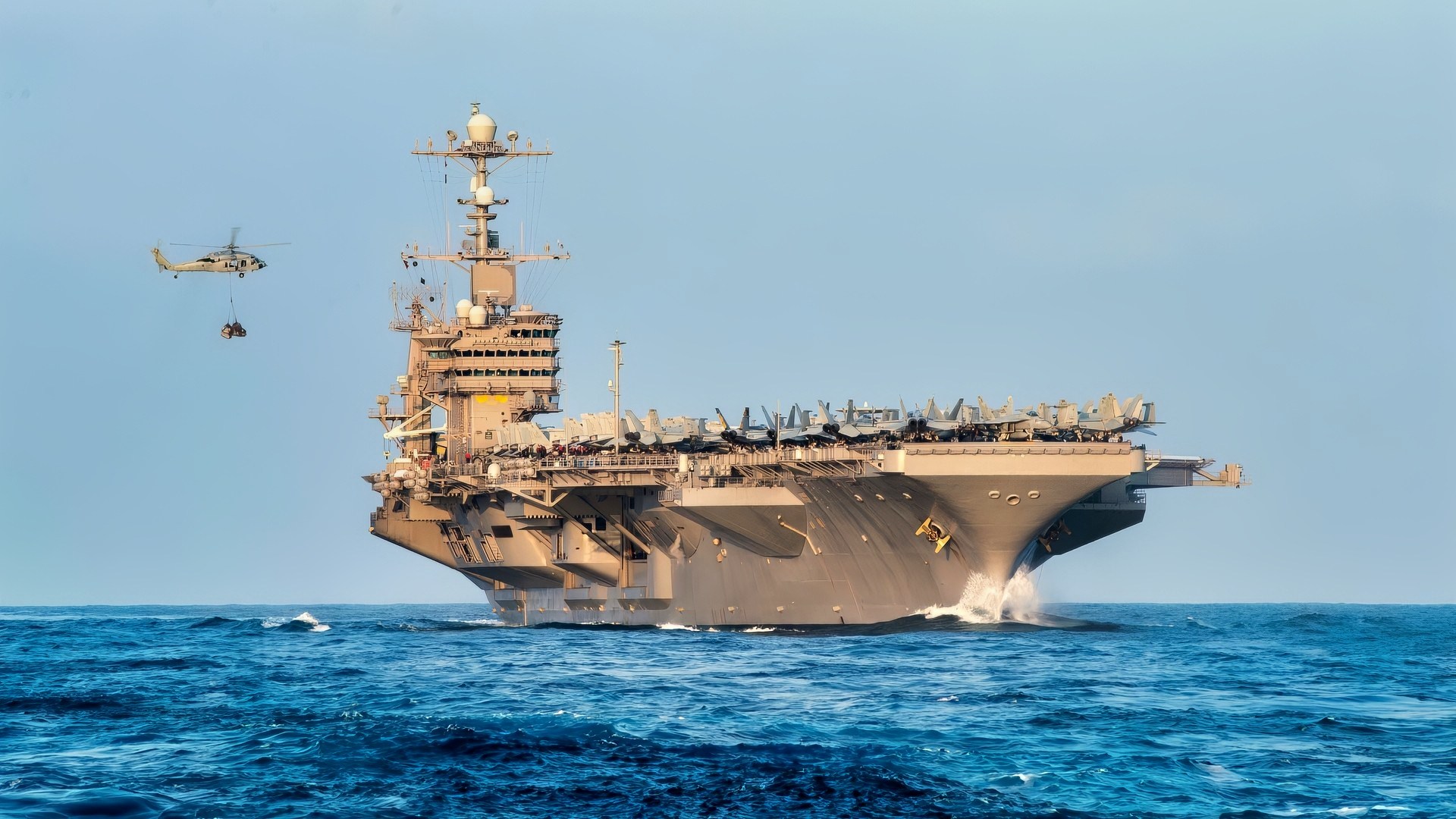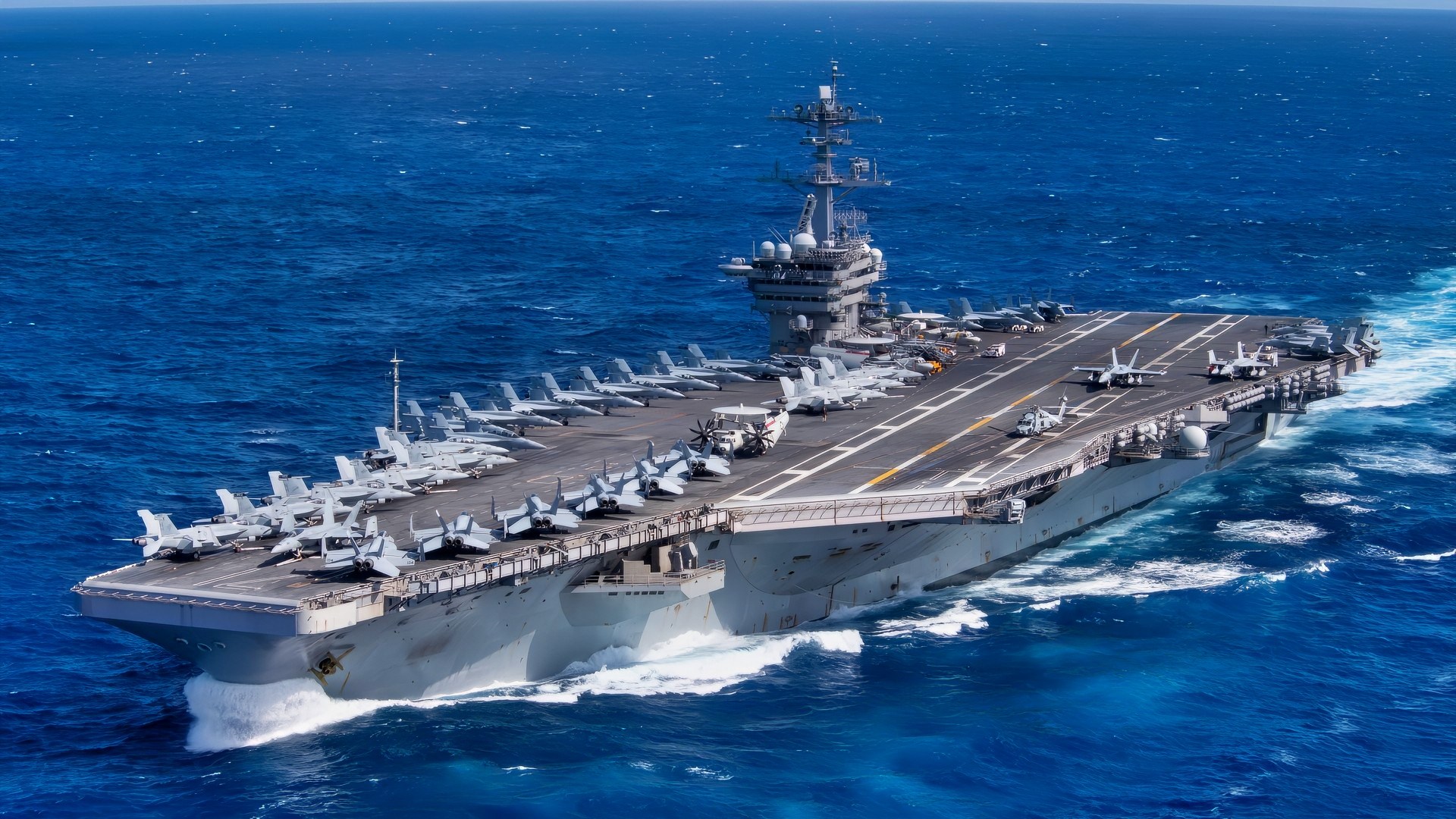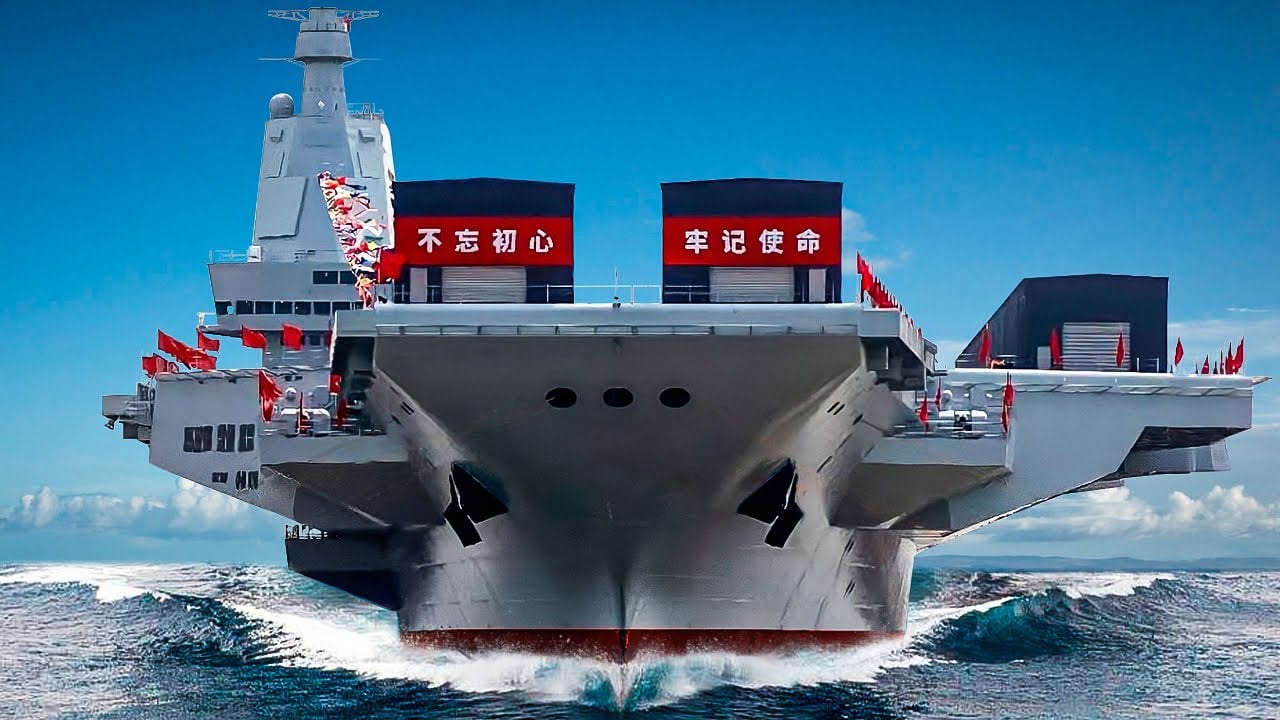Key Points and Summary – While China is rapidly building carriers (3 operational, 1 in progress), a critical analysis argues its navy is “far behind” the U.S. due to a “100-year experience gap.”
-The U.S. Navy has decades of combat experience and advanced tech (like “magic carpet” landing software), whereas the PLAN is “still learning” basic night/weather operations, “lacks” a carrier-based early warning aircraft (KJ-600 “still in testing”), and keeps its “vulnerable” carriers close to shore.

(Feb. 25, 2019) The aircraft carrier USS John C. Stennis (CVN 74) transits the South China Sea at sunset, Feb. 25, 2019. The John C. Stennis Carrier Strike Group is deployed to the U.S. 7th Fleet area of operations in support of security and stability in the Indo-Pacific region. (U.S. Navy photo by Mass Communication Specialist 1st Class Ryan D. McLearnon/Released)
-China’s recent 3-carrier drill is dismissed as a “photo opportunity,” not proof of the complex, 24-hour warfighting capability the U.S. has mastered.
China’s Aircraft Carriers Still Are Far Behind US Carriers In Many Aspects
As China builds naval vessels at an incredible rate, Beijing is trying to build up a fleet of six aircraft carriers.
China currently has three carriers, but two are older models. One is the Soviet-built, retrofitted Liaoning, which carries 24 fighters. Another is the indigenously built Shandong, another ski-jump type carrier that is slightly larger and carries eight additional aircraft. Their third carrier is the much more modern Fujian, which operates with an electromagnetic catapult.
The Fujian carries about 40 fighter jets but is conventionally powered, so its range without refueling is limited. The People’s Liberation Army Navy’s (PLAN’s) fleet of oilers is limited and would provide vulnerable targets for U.S. forces.
China is currently in the process of building a massive supercarrier similar to the U.S. Ford-class.
This year, the PLAN operated all three of its Carrier Strike Groups (CSGs) together for the first time. This had armchair analysts claiming that the Chinese CSGs would soon match U.S. carriers.
Not so fast.
China’s Carrier Strike Groups Still Have A Long Way To Go
Chinese aircraft carriers still have a long way to go to match the U.S. Navy. There are significant gaps in operational experience, crew training, and military doctrine.
While China is rapidly advancing technologically, it faces significant challenges in areas including sustained 24-hour air operations, anti-submarine warfare, and logistical support at sea that can only be developed with time and experience.

China Aircraft Carrier. Image Credit: Creative Commons.
The PLAN lacks the decades of real-world experience the U.S. has in conducting complex, sustained carrier operations.
Chinese aircraft and systems integration are also behind the U.S. While China’s new carriers can launch jets with electromagnetic catapults, the U.S. has more advanced landing software and more battle-tested systems. For example, China still lacks a carrier-based early warning aircraft and relies on land-based planes for some functions.
100-Year Experience Gap:
China has a 100-year experience gap with the U.S. Navy and is still learning how to operate carriers effectively, especially in complex scenarios and harsh environments.
Landing aircraft at night and in bad weather, for instance—a capability crucial to regular offshore carrier operations—remains far from a routine task, several Navy attaches and analysts told the Times of San Diego.
The United States started doing this before World War II, and it is a daily routine for American carrier pilots.
Night Operations, Bad Weather, Carrier Protection Not Ready
As I wrote back in April, Chinese carriers still operate close to Chinese shores and under the protection of their A2/AD systems. In many instances, Chinese pilots take off or land from Chinese airfields, rather than from the carriers.

(Aug. 1, 2016) – The Nimitz-class aircraft carrier USS John C. Stennis (CVN 74) receives stores while conducting a vertical replenishment at sea, during Rim of the Pacific 2016. Twenty-six nations, more than 40 ships and submarines, more than 200 aircraft and 25,000 personnel are participating in RIMPAC from June 30 to Aug. 4, in and around the Hawaiian Islands and Southern California. The world’s largest international maritime exercise, RIMPAC provides a unique training opportunity that helps participants foster and sustain the cooperative relationships that are critical to ensuring the safety of sea lanes and security on the world’s oceans. RIMPAC 2016 is the 25th exercise in the series that began in 1971. (U.S. Navy photo by Mass Communication Specialist 2nd Class Ryan J. Batchelder)

ARABIAN SEA (Dec. 14, 2018) The Nimitz-class aircraft carrier USS John C. Stennis transits the Arabian sea with the Essex Amphibious Ready Group (ARG) and 13th Marine Expeditionary Unit (MEU). The John C. Stennis Carrier Strike Group, Essex ARG, and 13th MEU are conducting integrated operations in the Arabian Sea to ensure stability in the Central Region, connecting the Mediterranean and the Pacific through the western Indian Ocean and three strategic choke points. (U.S. Navy photo by Mass Communication Specialist 3rd Class Tyler Diffie)

(Jan. 25, 2020) The aircraft carrier USS Theodore Roosevelt (CVN 71) transits the Pacific Ocean Jan. 25, 2020. The Theodore Roosevelt Carrier Strike Group is on a scheduled deployment to the Indo-Pacific. (U.S. Navy photo by Mass Communication Specialist Seaman Kaylianna Genier)
The IISS recently analyzed a joint carrier operation conducted by the Liaoning and Shandong carriers, along with their respective escort groups. The analysis showed a leap in Chinese naval capability. China’s state-run media portrayed the operation in much the same way the U.S. Navy does—as a projection of regional power.
But did the operation demonstrate an actual capability to conduct complex multi-carrier operations? Or was it just a photo opportunity? The U.S. Navy has been conducting these operations for more than 80 years. The Chinese have demonstrated their intention to perform such operations, but mastering the needed skills requires time.
Night operations and operations in adverse weather conditions are staples of American carrier operations, as are continuous flight operations, which the Chinese have yet to master.
“The continuous operation of its carriers sits at the very core of what makes the U.S. military absolutely preeminent,” said Singapore-based defense analyst Alexander Neill.
Protective Screening And Missile Defense Needs Improvement:
China loves to tout its “carrier killer” missiles, but what they and most analysts fail to mention is that China’s carriers are even more vulnerable to U.S. anti-ship missiles. China’s carriers would be vulnerable to missile and submarine attacks. Analysts note the PLAN has not perfected protective screening operations, particularly anti-submarine warfare.
Chinese carriers operate without early-warning aircraft, relying on land-based aircraft for the task. This is not conducive to operating anywhere except near China’s own shores. A new aircraft, the KJ-600, designed to perform a similar role to the E-2C/D Hawkeye launched from U.S. carriers, is still in testing, according to the Pentagon’s latest annual report on China’s military.
China’s Carriers Are Meant To Operate Close To Its Shores
China’s aircraft carriers have limited anti-missile defenses, because they are designed to operate under the protection of land-based missile networks.
They rely on land-based missile systems to create an anti-access bubble, a stark contrast to U.S. carriers, which are built to be self-sufficient and operate as the core of a wider network.
Because of this, China’s naval strategy places emphasis on asymmetric warfare, using long-range anti-ship missiles to threaten enemy carriers from a distance. In contrast, their own carriers remain relatively vulnerable to direct attack.
China is far from having CSGs that project power beyond its own shores. Building modern carriers is one thing. Learning to operate them in a constant state of readiness and on a war footing is quite another. And China is still at least a decade, perhaps several decades, behind.
About the Author: Steve Balestrieri
Steve Balestrieri is a National Security Columnist. He served as a US Army Special Forces NCO and Warrant Officer. In addition to writing on defense, he covers the NFL for PatsFans.com and is a member of the Pro Football Writers of America (PFWA). His work was regularly featured in many military publications.
More Military
The M113: America’s “Forgotten” APC That Just Won’t Quit
How British Aircraft Carriers Keep Sinking in War Games
Boeing F-47 NGAD Fighter: One Missing Fact Could Decide Its Fate
Canada Knows How to Sink U.S. Navy Nuclear Aircraft Carriers











Jim
November 7, 2025 at 12:58 pm
The author is right to point out the experience gap.
It’s real.
But numbers are telling and while China’s aircraft carriers are not what the United States Navy fields, it’s mission is limited at present to coastal waters around Taiwan and possibly into the South China Sea.
China may not need the same level of institutional, multi-generation experience the U. S. Navy has under its belt.
Naval power, as determined by a balance of forces analysis, in the Western Pacific is undoubtedly changing from an assumed unrivaled dominance of the United States Navy.
This likely is one of the reasons for the surprising new Rand Corporation report advising for a shift in strategic policy vis-a-vis China: manage an ongoing relationship without pointing for an eventual conflict or the attempt to achieve a strategic, hegemonic dominance versus China.
The Rand Corporation is a think-tank long associated with the Pentagon and viewed as influential in military and foreign policy thinking and planning.
China’s tech is fast catching up, if not nearly at parity, but the numbers of all things military they can produce is eye popping.
And should inform us. Industrial capacity for industrial war, numbers… and numbers… for an attrition which is part of the strategic balance.
Quite possibly the shifting military balance vis-a-vis China is the main reason for the surprising turn of face out of the Rand Corporation, a long-time advocate for aggressive policies, both covert & overt, to achieve Full-Spectrum Dominance the world over.
The military reality should inform our foreign policy and that should spur a Peace through Strength strategy of diplomacy first and exhausting all diplomatic channels before turning to the military as a last resort, if necessary.
Brian Herberger
November 7, 2025 at 10:33 pm
If this were true, China wouldn’t have a fleet at all and would be of zero concern. Sure we have an experience edge, but I would prefer the numbers edge they have.
Brian Herberger
November 7, 2025 at 10:40 pm
Well I can tell Jim is far too smart and rational to have served in the military. This is meant 100% as a compliment and if you did serve I’m curious as to what you did. Your last paragraph is spot on and I would hope both sides of the isle realize it’s clearly the way to go we have to start spending our defense budget more wisely. I would suggest investing in real intelligence and less on killing machines.